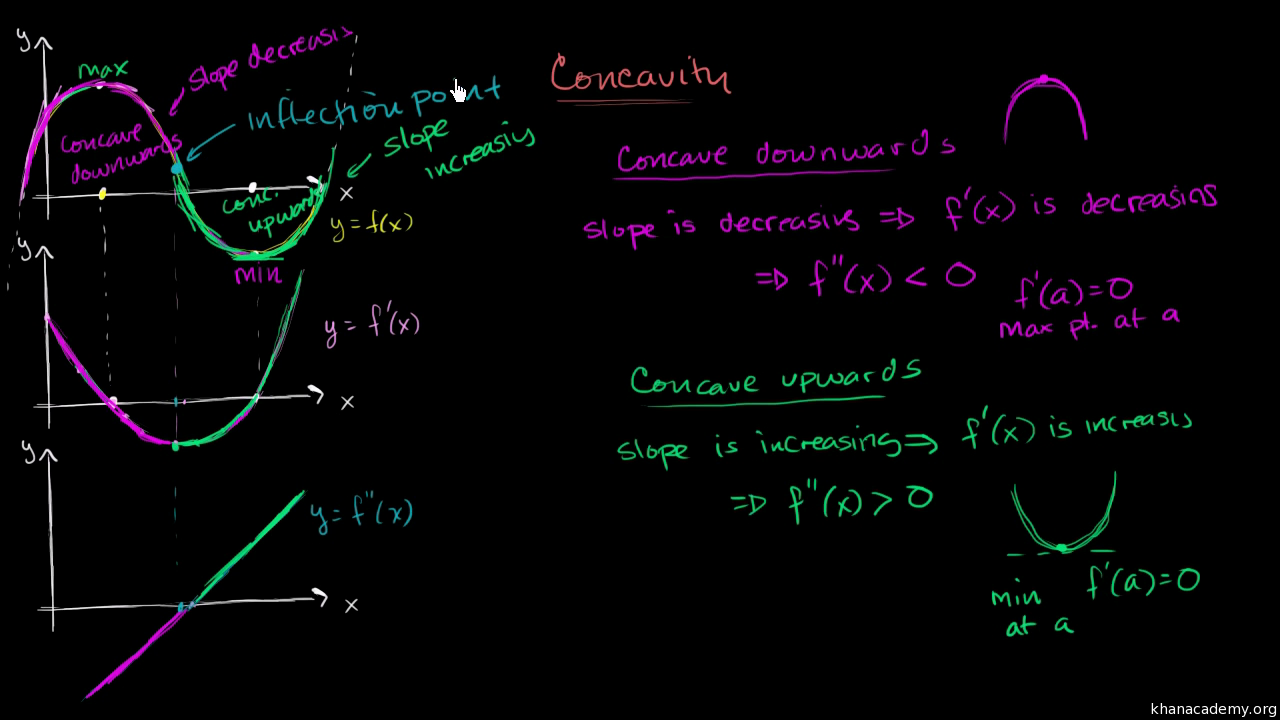Original post by NinCheng
Why is it that I can differentiate a function twice to determine whether I have a maximum or minimum?
Cuz the book says so?
Original post by M14B
Cuz the book says so?
You're not funny

Original post by NinCheng
You're not funny 

Do you have to dent my confidence?

Original post by NinCheng
Why is it that I can differentiate a function twice to determine whether I have a maximum or minimum?
Technical reason: because it gives information on concavity.
Here's a picture that sums it up:

But basically, if the second derivative is negative, that means your gradient is just going to get shallower and shallower since the gradient is then a decreasing function, so the function will decrease since the gradient is getting shallower hence that point is a maximum.
If the second derivative is positive, that means your gradient is getting steeper and steeper and hence the function will only grow from there, hence it's a minimum.
Original post by Zacken
Technical reason: because it gives information on concavity.
Here's a picture that sums it up:

But basically, if the second derivative is negative, that means your gradient is just going to get shallower and shallower since the gradient is then a decreasing function, so the function will decrease since the gradient is getting shallower hence that point is a maximum.
If the second derivative is positive, that means your gradient is getting steeper and steeper and hence the function will only grow from there, hence it's a minimum.
Here's a picture that sums it up:

But basically, if the second derivative is negative, that means your gradient is just going to get shallower and shallower since the gradient is then a decreasing function, so the function will decrease since the gradient is getting shallower hence that point is a maximum.
If the second derivative is positive, that means your gradient is getting steeper and steeper and hence the function will only grow from there, hence it's a minimum.
Cheers, slightly understand. Need to do a bit of research on that word 'Concavity'
What is this KA video called?
Original post by NinCheng
Cheers, slightly understand. Need to do a bit of research on that word 'Concavity'
What is this KA video called?
What is this KA video called?
Here you go.
Quick Reply
Related discussions
- GCSE Biology
- Differentiation
- Does anyone know a sheet with all the differentiated and integrated functions?
- a level maths differentiation product rule question
- Maclaurin Series Question
- Differentiation
- Maths Problem
- SHM
- find an expression for the gradient of y=e^3.2x
- Intergrate
- A level maths mechanics question (1)
- Help integration
- Help differentiation
- GCSE Biology
- C3
- Biology - cell differentiation
- Differentiation Question
- Implicit Differentiation 2
- Fourier series minimize integral
- maths question help
Latest
Trending
Last reply 2 days ago
Did Cambridge maths students find maths and further maths a level very easy?Last reply 2 weeks ago
Edexcel A Level Mathematics Paper 2 unofficial mark scheme correct me if wrongMaths
71
Trending
Last reply 2 days ago
Did Cambridge maths students find maths and further maths a level very easy?Last reply 2 weeks ago
Edexcel A Level Mathematics Paper 2 unofficial mark scheme correct me if wrongMaths
71



